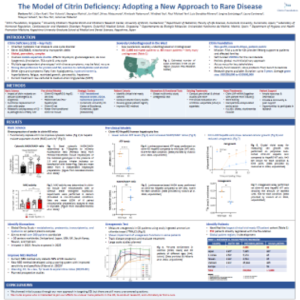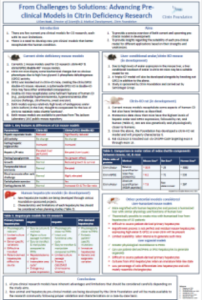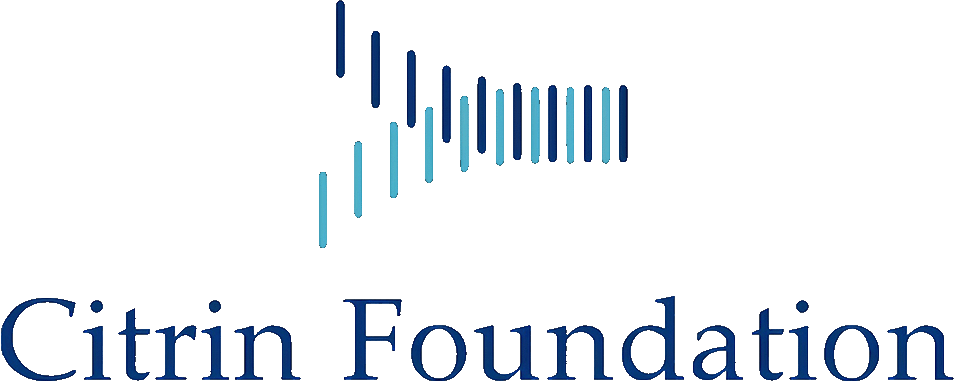2024
Society for the Study of Inborn Errors of Metabolism (SSIEM) Annual Symposium, Porto, Portugal
At the SSIEM Annual Symposium, Citrin Foundation showcased a poster titled “Unravelling the Enigma of Citrin Deficiency: A Novel Holistic Multidisciplinary Approach”.
The poster emphasized the complexity of citrin deficiency, highlighted key research questions, and detailed the Foundation’s comprehensive strategy for addressing these challenges to advance the development of effective treatments. It also encouraged collaboration, inviting those with an interest in progressing research and therapeutic approaches for citrin deficiency to join the Foundation’s efforts.

Abstract
Background
Citrin deficiency (CD) is a pan-ethnic, complex inherited liver metabolic disease and urea cycle disorder caused by mutations in the
SLC25A13 gene, encoding the mitochondrial aspartate glutamate carrier (AGC2) protein. It affects multiple metabolic pathways,
including the malate-aspartate shuttle, glycolysis, gluconeogenesis, de novo lipogenesis, beta-oxidation, the TCA and urea cycles.
Due to its unique role in metabolism, its heterogeneous phenotypes and diverse symptoms, it poses significant diagnostic and
therapeutic challenges. Citrin Foundation therefore aims to elucidate the pathogenesis of CD using a holistic and multidisciplinary
approach, with the ultimate goal of finding a cure.
Case Study/Methods
Significant funding and resources have been committed to these goals. A comprehensive assessment of the CD landscape was
undertaken, leading to the implementation of a holistic strategy ranging from basic science research to translational research to
clinical initiatives and studies. A multidisciplinary consortium of clinicians, scientists and biotech companies was established and
linked to work together collaboratively. Rigorous grant review processes ensured that targeted projects were funded. Patients
were mobilized and supported.
Results
The effects of mutations on citrin protein function, bioenergetics, and biogenesis were investigated. New preclinical models were
developed to better recapitulate human CD. Flux studies were used to analyse the metabolic consequences of CD. Large patient
cohorts were assembled for studies such as a multi-omics study to identify biomarkers. Improved newborn screening methods were
devised. Ureagenesis tests were performed in patients. Strategic centres were established. Various therapeutic options, from small
molecules to gene editing, are being evaluated.
Discussion/Conclusion
Despite our early success, advancing technologies can further our goals. We invite others to use innovative methods to unravel this
metabolic enigma, which will have scientific implications beyond CD.
Abstract
Background
Citrin deficiency (CD) is a pan-ethnic, complex inherited liver metabolic disease and urea cycle disorder caused by mutations in the
SLC25A13 gene, encoding the mitochondrial aspartate glutamate carrier (AGC2) protein. It affects multiple metabolic pathways,
including the malate-aspartate shuttle, glycolysis, gluconeogenesis, de novo lipogenesis, beta-oxidation, the TCA and urea cycles.
Due to its unique role in metabolism, its heterogeneous phenotypes and diverse symptoms, it poses significant diagnostic and
therapeutic challenges. Citrin Foundation therefore aims to elucidate the pathogenesis of CD using a holistic and multidisciplinary
approach, with the ultimate goal of finding a cure.
Case Study/Methods
Significant funding and resources have been committed to these goals. A comprehensive assessment of the CD landscape was
undertaken, leading to the implementation of a holistic strategy ranging from basic science research to translational research to
clinical initiatives and studies. A multidisciplinary consortium of clinicians, scientists and biotech companies was established and
linked to work together collaboratively. Rigorous grant review processes ensured that targeted projects were funded. Patients
were mobilized and supported.
Results
The effects of mutations on citrin protein function, bioenergetics, and biogenesis were investigated. New preclinical models were
developed to better recapitulate human CD. Flux studies were used to analyse the metabolic consequences of CD. Large patient
cohorts were assembled for studies such as a multi-omics study to identify biomarkers. Improved newborn screening methods were
devised. Ureagenesis tests were performed in patients. Strategic centres were established. Various therapeutic options, from small
molecules to gene editing, are being evaluated.
Discussion/Conclusion
Despite our early success, advancing technologies can further our goals. We invite others to use innovative methods to unravel this
metabolic enigma, which will have scientific implications beyond CD.
.
45th Society for Inherited Metabolic Disorders (SIMD) Annual Meeting, Charlotte, North Carolina
At the 45th SIMD Annual Meeting, Citrin Foundation showcased a poster titled “The Model of Citrin Deficiency: Adopting a New Approach to Rare Disease”.
The poster delved into the scientific and clinical background of citrin deficiency, outlining the multidisciplinary and diverse methodologies adopted to address this complex condition. It further highlighted the need to improve diagnosis and awareness in North America and provided an in-depth overview of the Foundation’s novel approach towards solving citrin deficiency. The findings of several Foundation-sponsored studies were also showcased.

Abstract
Background
Citrin deficiency (CD) is a rare metabolic condition due to mutations in the SLC25A13 gene encoding citrin. Citrin is the mitochondrial aspartate-glutamate carrier, a component of the malate-aspartate shuttle, involved in moving reducing equivalents (NADH) from the cytosol into the mitochondria and for supplying aspartate to the cytosol. CD is a complex disorder with diverse phenotypes. It primarily affects the liver with several major pathways including glycolysis, gluconeogenesis, lipid metabolism, the TCA cycle and ureagenesis being impacted.
Based on published carrier rates in several East Asian ethnicities and considering their respective populations, the expected number of CD patients in the United States would be approximately 2,000. However, there are currently <50 cd patients in the us known to scientific community. close
this dramatic gap diagnosis, citrin foundation, a non-profit, research-driven, patient-centric organization dedicated finding cure for cd, proposes new long-term, holistic, innovative, global and multidisciplinary approach tackle rare diseases, using as model disease.
Methods
Acting as a nexus, Citrin Foundation brings together key stakeholders (researchers, clinicians, patients, biotech) to solve problems from bench to bedside, and has committed substantive resources for its cause over the next decade (https://citrinfoundation.org/).
For basic science, we are studying the intracellular localization, transport activity, and biogenesis consequences of pathogenic SLC25A13 variants and developing new preclinical models. For clinical strategy, we seek to identify more patients in preparation of cohort studies and patient registries. Before interventional studies for CD can begin, a reliable biomarker and functional assays to monitor disease progression must be established. A range of treatments are being investigated, from small molecules that may ameliorate the impact of the disease to gene therapies. Patients and families are provided with information, support and encouragement to participate in clinical studies. Below, some initial results are listed.
Results
In basic science, Citrin-knockout HepG2 cells were shown to have lower ATP production, increased NADH/NAD+ ratios, and reduced mitochondrial maximum respiratory capacity, indicating their potential as a CD model. Another preclinical study showed that aralar, a protein highly homologous to citrin, with identical function, can functionally replace citrin in the mouse liver. For improving diagnosis to identify more patients, a new scoring system for CD using the present NBS system was devised with improved specificity and sensitivity. For biomarker detection, we are currently conducting a multi-omics study in >300 patients, some of whom will also be studied for their ureagenesis function using stable isotopes flux methods. In initial treatment investigations, nicotinamide riboside was shown to rescue dysregulated glycolysis and fatty acid β-oxidation in Citrin-knockout HepG2 cells. L-ornithine L-aspartate was shown to reduce hyperammonemia in a Citrin/mGPD double-knockout mouse model.
Conclusions
CD is severely underdiagnosed in many parts of the Western world. The approach proposed by Citrin Foundation foresees overcoming many of the universal challenges in tackling rare diseases by fostering a global consortium of scientists, clinicians, and biotech companies working together with patients collaboratively. The success of this approach is demonstrated by its first achievements that hopefully encourage others to join our consortium.
Abstract
Background
Citrin deficiency (CD) is a rare metabolic condition due to mutations in the SLC25A13 gene encoding citrin. Citrin is the mitochondrial aspartate-glutamate carrier, a component of the malate-aspartate shuttle, involved in moving reducing equivalents (NADH) from the cytosol into the mitochondria and for supplying aspartate to the cytosol. CD is a complex disorder with diverse phenotypes. It primarily affects the liver with several major pathways including glycolysis, gluconeogenesis, lipid metabolism, the TCA cycle and ureagenesis being impacted.
Based on published carrier rates in several East Asian ethnicities and considering their respective populations, the expected number of CD patients in the United States would be approximately 2,000. However, there are currently <50 cd patients in the us known to scientific community. close
this dramatic gap diagnosis, citrin foundation, a non-profit, research-driven, patient-centric organization dedicated finding cure for cd, proposes new long-term, holistic, innovative, global and multidisciplinary approach tackle rare diseases, using as model disease.
Methods
Acting as a nexus, Citrin Foundation brings together key stakeholders (researchers, clinicians, patients, biotech) to solve problems from bench to bedside, and has committed substantive resources for its cause over the next decade (www.https://citrinfoundation.org/).
For basic science, we are studying the intracellular localization, transport activity, and biogenesis consequences of pathogenic SLC25A13 variants and developing new preclinical models. For clinical strategy, we seek to identify more patients in preparation of cohort studies and patient registries. Before interventional studies for CD can begin, a reliable biomarker and functional assays to monitor disease progression must be established. A range of treatments are being investigated, from small molecules that may ameliorate the impact of the disease to gene therapies. Patients and families are provided with information, support and encouragement to participate in clinical studies. Below, some initial results are listed.
Results
In basic science, Citrin-knockout HepG2 cells were shown to have lower ATP production, increased NADH/NAD+ ratios, and reduced mitochondrial maximum respiratory capacity, indicating their potential as a CD model. Another preclinical study showed that aralar, a protein highly homologous to citrin, with identical function, can functionally replace citrin in the mouse liver. For improving diagnosis to identify more patients, a new scoring system for CD using the present NBS system was devised with improved specificity and sensitivity. For biomarker detection, we are currently conducting a multi-omics study in >300 patients, some of whom will also be studied for their ureagenesis function using stable isotopes flux methods. In initial treatment investigations, nicotinamide riboside was shown to rescue dysregulated glycolysis and fatty acid β-oxidation in Citrin-knockout HepG2 cells. L-ornithine L-aspartate was shown to reduce hyperammonemia in a Citrin/mGPD double-knockout mouse model.
Conclusions
CD is severely underdiagnosed in many parts of the Western world. The approach proposed by Citrin Foundation foresees overcoming many of the universal challenges in tackling rare diseases by fostering a global consortium of scientists, clinicians, and biotech companies working together with patients collaboratively. The success of this approach is demonstrated by its first achievements that hopefully encourage others to join our consortium.
.
2023
Citrin Foundation 2nd In-Person Global Symposium, Cambridge, United Kingdom
At the 2nd In-Person Global Citrin Deficiency Symposium hosted by Citrin Foundation at Magdalene College, University of Cambridge, the Foundation showcased a poster titled “From Challenges to Solutions: Advancing Pre-clinical Models in Citrin Deficiency Research”.
The poster provided an overview of the current pre-clinical research models for citrin deficiency, highlighting their limitations and the need for better models that more accurately mimic the human condition. It also presented an overview of ongoing Foundation-sponsored studies developing new cellular and animal models for citrin deficiency, offering detailed insights into the suitability of each model for various research purposes.
Citrin Foundation 2nd In-Person Global Symposium, Cambridge, United Kingdom
At the 2nd In-Person Global Citrin Deficiency Symposium hosted by Citrin Foundation at Magdalene College, University of Cambridge, the Foundation showcased a poster titled “From Challenges to Solutions: Advancing Pre-clinical Models in Citrin Deficiency Research”.
The poster provided an overview of the current pre-clinical research models for citrin deficiency, highlighting their limitations and the need for better models that more accurately mimic the human condition. It also presented an overview of ongoing Foundation-sponsored studies developing new cellular and animal models for citrin deficiency, offering detailed insights into the suitability of each for various research purposes.

Abstract
Preclinical models play a crucial role in enhancing our understanding of citrin deficiency (CD) and assessing potential therapies. However, the available preclinical models for CD research are currently limited. Most studies have relied on the citrin-KO and citrin/mGPD double-KO mouse models, along with initial attempts to establish a human hepatocyte cell line model. While these models have provided valuable insights, they also have inherent limitations. To address this issue, the Citrin Foundation has comprehensively evaluated the preclinical research landscape and actively pursuing the development of novel cellular and animal models to facilitate CD research. Ongoing Foundation-sponsored projects involve creating citrin knock-out and/or citrin mutant knock-in models of human hepatocyte lines (e.g., HepaRG, HepG2) and citrin-KO animal models (e.g., liver-conditional aralar-KO mouse model, citrin-KO rat model). This presentation aims to provide a detailed evaluation of current and upcoming preclinical models for CD research, discussing their respective advantages and limitations.
Abstract
Preclinical models play a crucial role in enhancing our understanding of citrin deficiency (CD) and assessing potential therapies. However, the available preclinical models for CD research are currently limited. Most studies have relied on the citrin-KO and citrin/mGPD double-KO mouse models, along with initial attempts to establish a human hepatocyte cell line model. While these models have provided valuable insights, they also have inherent limitations. To address this issue, the Citrin Foundation has comprehensively evaluated the preclinical research landscape and actively pursuing the development of novel cellular and animal models to facilitate CD research. Ongoing Foundation-sponsored projects involve creating citrin knock-out and/or citrin mutant knock-in models of human hepatocyte lines (e.g., HepaRG, HepG2) and citrin-KO animal models (e.g., liver-conditional aralar-KO mouse model, citrin-KO rat model). This presentation aims to provide a detailed evaluation of current and upcoming preclinical models for CD research, discussing their respective advantages and limitations.


